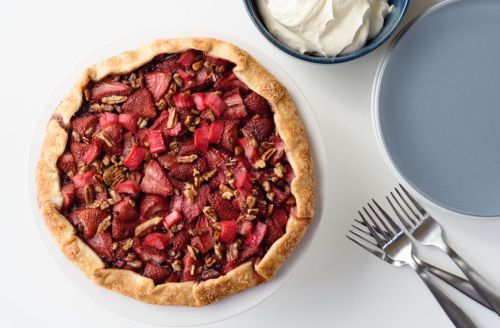It’s rhubarb season, so take advantage of its surprising health benefits in your cooking
Rhubarb season is only for a short time in spring—so make the most of it by learning all about its health benefits and how to use it in the kitchen.

If you hear “rhubarb” and think “pie,” you’re not alone. In fact, the spring vegetable is sometimes referred to as “the pie plant,” thanks to how often it is paired with sugar, butter, flour and a flaky crust.
There’s actually a lot more to rhubarb beyond desserts, including the fact that it boasts some serious nutritional benefits. (Also, it’s kind of related to buckwheat? Who knew.) Here’s everything you need to know about the vibrant vegetable and the recipe inspiration you need to put it to work in the kitchen. It’s only in season for a short period of time (April through June) so we promise to make this quick!
What are main rhubarb health benefits I should know about?
Before we dive in to the benefits of rhubarb, it’s worth taking a peek at its nutritional properties. Nora Minno, a registered dietitian and certified personal trainer in New York City, says one cup of the colorful vegetable contains the following:
- Calories: 26
- Fat: Less than 1 gram
- Fiber: 2 grams
- Protein: 1 gram
- Carbohydrates: 6 grams
- Sugar: 1 gram
Beyond the nutrition label-type stuff, here are a few more healthy reasons why you should make rhubarb a part of your regular diet if you can:
1. It’s a good source of fiber. Like many fruits and vegetables, rhubarb has a decent amount of fiber—about 2 grams per cup, chopped. Fiber, of course, is great for your digestive health and can help lower blood cholesterol levels. Most of us aren’t eating enough, so stock up.
2. It’s good for bone and heart health. Minno says rhubarb is also a good source of vitamin K, containing approximately 26 to 37 percent of the recommended daily intake (RDI) in a 3.5 oz serving. Vitamin K is essential for blood clotting, strong bones and maintaining heart health. According to a report published in Nutrition in Clinical Practice, vitamin K has “a positive effect on bone mineral density and decreases fracture risk,” even guarding against osteoporosis.
Minno says rhubarb also has 10 percent of your daily calcium needs in every cup. Calcium, like vitamin K, also supports bone and tooth health as well as blood clotting.
3. It boasts more of an antioxidant punch than kale. Rhubarb is rich in phenolic acid, an antioxidant found in cherries, red cabbage, red wine and green tea that supports healthy skin and protects your body from free radical damage. A study published in 2012 found that rhubarb contains even more phenolic acid than nutrient-packed kale.
4. It could help fight inflammation. In addition to phenolic acid, rhubarb also contains anthocyanins, a type of flavonoid that gives fruits and vegetables their antioxidant-rich red, blue and purple hues. According to a 2010 study, “anthocyanins possess anti-inflammatory and anti-carcinogenic activity, cardiovascular disease prevention, obesity control, and diabetes alleviation properties, all of which are more or less associated with their potent antioxidant property.”
5. It might help with digestion. Rhubarb has also been studied for its ability to treat digestive issues and gastrointestinal disorders. A 2014 study even showed that the tannins in rhubarb can help to regulate water absorption in the digestive tract of mice, therefore aiding in the prevention of diarrhea.
Are there any side effects to consuming rhubarb?
“If you have a history of developing kidney stones, it is best to avoid rhubarb,” says Vandana Sheth, RD, a registered dietitian and spokesperson for the Academy of Nutrition and Dietetics. That’s because rhubarb is rich in calcium oxalate, a compound that in excess can contribute to kidney stones. Sheth says to avoid the leaves since they have the highest amounts of calcium oxalate and can make you sick; stick to the pretty pink stalks and you should be good to go.
How do I eat it?
Rhubarb isn’t exactly known for its sweetness—in fact, it’s pretty sour from the get-go. But with a bit of creativity, you can find ways to incorporate it into your diet to add a big more complexity to the flavors you eat. It’s commonly paired with strawberries to get a sweet-sour kind of vibe, but it can also just be eaten raw with a little sugar or honey to cut down on the tart flavor.
As for cooking, there are tons of way to get your rhubarb on with baked oatmeal, salad dressings, chia seed pudding and even a healthy rhubarb crumble find unique ways to incorporate the vegetable into your next meal. It also makes for a great waffle topping in case you don’t like them to be overly sweet.
Some more spring produce with amazing health benefits: asparagus and pears.
Sign Up for Our Daily Newsletter
Get all the latest in wellness, trends, food, fitness, beauty, and more delivered right to your inbox.
Got it, you've been added to our email list.










